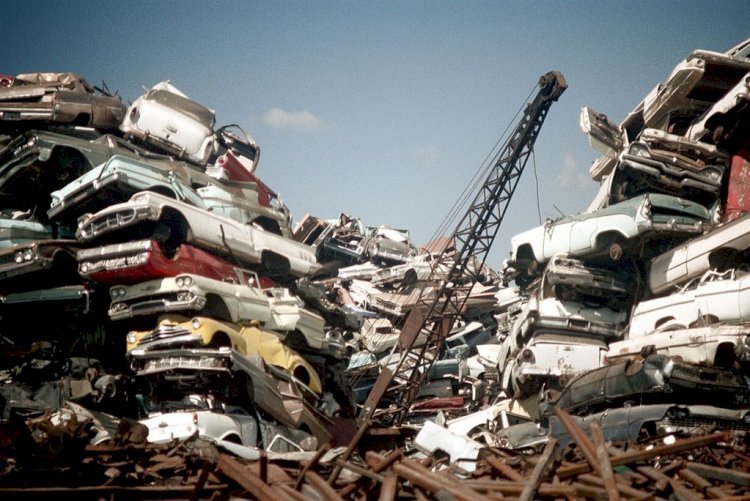The Environmental Impact of Car Scrapping & Recycling (2025 Guide)
Discover how car scrapping reduces waste, saves energy, lowers CO₂ emissions, and supports recycling. Learn the global benefits of vehicle recycling.

Each year, millions of vehicles reach the end of their useful life worldwide, creating a significant environmental challenge that requires careful management. Car scrapping and vehicle recycling have emerged as crucial processes in addressing this challenge, transforming what was once considered waste into valuable resources whilst protecting our planet from harmful pollutants. Understanding the environmental impact of proper car disposal reveals how this industry has become an unsung hero in the fight against climate change and resource depletion.
The Scale of the Challenge

Image source: Pinterest.com
The automotive industry is one of the largest manufacturing sectors in the world, and with it comes the inevitable issue of end-of-life vehicle disposal. In the UK alone, around 1.5–2 million vehicles are scrapped every year, while globally the figure reaches approximately 27 million vehicles annually.
Without effective car scrapping systems, these discarded vehicles would present enormous environmental problems, from toxic soil and water contamination to overwhelming landfill use. The sheer volume of materials involved makes well-organised car scrapping programmes essential for both environmental protection and sustainable resource management.
Modern vehicles typically consist of about 60–65% steel and iron, 10–12% aluminium, 7–10% plastics, 3–4% rubber, 3–4% glass, with the remainder made up of fluids, electronics, and precious metals. This complex mix demands advanced recycling processes that can recover as many resources as possible while ensuring safe disposal of harmful substances.
Resource Recovery and Conservation

Image source: Pinterest.com
Car scrapping operations are highly effective in recovering valuable raw materials that would otherwise require energy-intensive mining and processing. Steel recovery is particularly significant: recycled steel uses 60–74% less energy than producing steel from virgin ore, preventing around 1.5–1.6 tonnes of CO₂ emissions for every tonne recycled.
Aluminium recovery brings even greater benefits. Recycling aluminium requires about 95% less energy than primary production, and prevents over 9 tonnes of CO₂ emissions per tonne compared to new aluminium. Since aluminium is widely used in engines, body panels, and wheels, these savings are substantial.
Precious metals such as platinum, palladium, and rhodium are also recovered from catalytic converters. Reusing these rare materials reduces demand for environmentally destructive mining and ensures a sustainable supply for future industries.
Hazardous Waste Management

Image source: Pinterest.com
End-of-life vehicles contain hazardous materials that must be carefully managed to prevent environmental damage. Fluids such as engine oil, transmission fluid, coolants, and brake fluids can cause serious soil and groundwater contamination if they are not removed and processed properly. Licensed recycling facilities use specialised equipment to drain and handle these fluids safely.
Batteries present another major challenge. Lead-acid batteries, which still power most conventional vehicles, have an impressive recycling rate of 95–99%, allowing recovered lead to be reused while preventing toxic contamination. With the growing number of hybrid and electric vehicles, the safe handling and recycling of lithium-ion batteries containing cobalt, nickel, and lithium has become increasingly important.
Air conditioning refrigerants also require special attention. If released into the atmosphere, they can contribute to ozone depletion and climate change. Professional scrapping facilities use certified equipment to capture and dispose of these gases safely, preventing thousands of tonnes of harmful emissions each year.
Carbon Footprint Reduction

Image source: Pinterest.com
The environmental benefits of car scrapping extend far into the area of carbon reduction. Recycling materials rather than producing them from scratch saves enormous amounts of energy and significantly cuts emissions. Steel recycling alone prevents more than a tonne of CO₂ emissions per tonne processed, while aluminium recycling offers even greater reductions.
In addition, remanufacturing vehicle components such as engines, alternators, and transmissions extends their useful life. This process uses up to 85% less energy than manufacturing new parts, which means fewer emissions and a more sustainable parts market. The location of recycling facilities also plays a role: when scrapping centres are close to major population areas, transportation distances are reduced, cutting fuel use and further lowering the overall carbon footprint.
Circular Economy Benefits

Image source: Pinterest.com
Car scrapping is a strong example of circular economy principles in action. Instead of following the traditional “take–make–dispose” model, the industry ensures that discarded vehicles become sources of valuable raw materials.
Steel and aluminium flow back into new manufacturing processes, while plastics recovered from vehicles are increasingly being reused in automotive parts or other industries. Though plastics are challenging to recycle due to their variety and contamination, advancing technologies are making recovery more effective.
The car recycling industry has also influenced vehicle design. Engineers are now incorporating “design-for-recycling” principles into new models, making it easier to dismantle and reuse parts at the end of a vehicle’s life. This forward-looking approach creates long-term environmental benefits throughout the entire lifecycle of a vehicle.
Innovation in Recycling Technology

Image source: Pinterest.com
Technology is continuing to transform the recycling process, improving both efficiency and environmental outcomes. Automated dismantling systems allow materials to be separated more accurately, while advanced sorting techniques such as magnetic, eddy current, and optical separation improve the quality of recovered resources.
Artificial intelligence and robotics are also being adopted in recycling facilities, helping to identify and extract components more effectively than traditional methods. At the same time, research into chemical recycling of plastics and pyrolysis of composite materials is opening new pathways for dealing with materials that have historically been very difficult to recycle.
Global Environmental Impact

Image source: Pinterest.com
The global environmental benefits of car scrapping are wide-reaching. Recycling steel reduces demand for iron ore mining, which causes deforestation, habitat loss, and water pollution. Similarly, aluminium recycling reduces reliance on bauxite mining, which is linked to deforestation and soil erosion in tropical regions, as well as the carbon-intensive smelting process.
By exporting recovered materials to international markets, countries with advanced scrapping systems also contribute to sustainable supply chains worldwide. This global redistribution ensures that recycled materials are reused in new products, reinforcing sustainability across multiple industries.
Future Challenges and Opportunities

Image source: Pinterest.com
The future of car scrapping presents both opportunities and challenges. The rise of electric vehicles introduces new recycling needs, particularly for lithium-ion batteries and rare earth elements used in motors. Developing effective recycling methods for these materials is essential for maximising the environmental benefits of EV adoption.
At the same time, lightweight materials and advanced composites used to make modern cars more fuel-efficient often present recycling difficulties due to their complex structures. Ongoing research into new recycling technologies for carbon fibre, plastics, and multi-material components will be critical in addressing these issues.
As vehicles incorporate more electronics, there are also opportunities to recover rare earth elements and semiconductors. Developing specialised recycling processes for these high-value components could further increase the environmental and economic benefits of car scrapping.
Conclusion
The environmental impact of car scrapping extends far beyond simple waste management. It delivers measurable benefits in resource recovery, pollution prevention, and carbon footprint reduction, while supporting a global circular economy.
Through advanced recycling processes, the automotive recycling industry transforms millions of end-of-life vehicles into valuable resources every year, preventing environmental contamination and reducing the demand for destructive mining.
As automotive technology evolves, the industry must continue to innovate in battery recycling, composite recovery, and electronics processing. The success of these efforts will ensure that car scrapping remains a cornerstone of sustainable resource management and environmental protection worldwide.
FAQs
1. What is car scrapping?
Car scrapping means recycling an old or damaged car so its parts and materials can be reused.
2. Why is car scrapping good for the environment?
It saves energy, reduces waste, and cuts down harmful pollution.
3. What materials are recycled from cars?
Steel, aluminium, plastics, glass, batteries, and even precious metals are recycled.
4. How does car scrapping reduce carbon emissions?
Recycling uses less energy than making new materials, so it creates fewer emissions.
5. What happens to car batteries during scrapping?
They are safely removed and recycled to stop toxic chemicals from polluting the earth.
6. Can parts from scrapped cars be reused?
Yes, many parts like engines, tyres, and alternators are refurbished and used again.




























